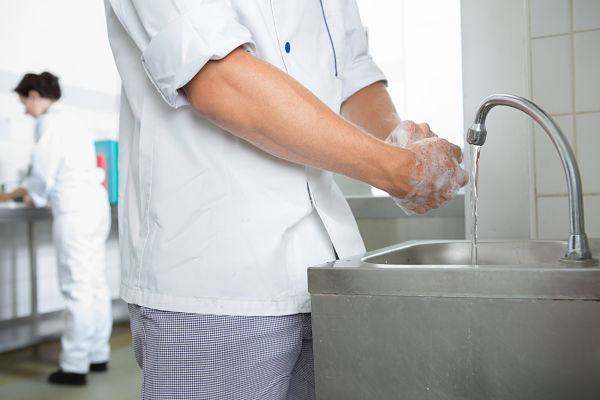The pandemic has made some aspects of dining out safer than ever; for instance, unprotected self-serve buffets and salad bars are likely a thing of the past. Menus and on-table salt and pepper shakers are recognized as some of the dirtiest items in any restaurant – and are now available in single-use form.
But what about the places in your kitchen where contaminants tend to gather? How do you know your staff are cleaning all of them – particularly the ones that are easy to overlook?
Just as a reminder, here are five areas that restaurants may not fully cover on their kitchen cleaning checklists.
1. The ice machine and accessories
Ice is clear and freezing cold. Who would ever consider that it could be dirty? Nonetheless, recent studies in the United Kingdom have found fecal bacteria in coffee-shop and fast-food-chain ice – and studies in the U.S. going back to the 1950s have had similar findings. While you would expect contaminants to be spread through hand contact or unclean storage containers, it’s also likely that they’re introduced through environmental conditions such as dust on the floors of freezing rooms and restaurants.
Your ice maker’s bin is often carefully checked by health inspectors. However, the inside of your machine, particularly the area above the chute, is both consistently wet and seldom cleaned or checked; this creates a home for black mold, fungus and other nasties that survive by surrounding themselves with “biofilm” that requires thorough disinfection and scrubbing to eliminate. Therefore, it’s important to not only follow your machine’s manufacturer’s instructions for thoroughly cleaning your machine, but to do it as often as possible.
Finally, ice scoops are a classic spreader of cross-contamination. Your checklist should cover putting the scoop into the dishwasher daily or, even better, at the end of every shift.
2. Dispenser nozzles
Have you closely examined your soda fountain dispenser nozzles recently? Because soda syrup is mostly sugar, it can create an excellent environment for the growth of all sorts of organisms. Your dispenser’s manufacturer has likely provided extensive guidelines and processes for cleaning the entire system including the nozzles.
We’re also including here every dispensing nozzle in your kitchen, which probably includes condiments. These should also be cleaned as often as possible according to manufacturer instructions.
3. Touchscreens
Does your kitchen include any sort of touchscreen technology? These could be a new addition that may not be adequately covered on your checklists. Check with your manufacturer’s recommendations, but they can likely be quickly disinfected by every shift.
4. Hands
Yes, we know – after surviving 2020, how is it possible that handwashing is not top of mind for every food-service employee everywhere? But a better question here is, are you positive that it is, for every employee on every shift?
Considering the year we’ve been through, a best practice is to have a separate checklist that covers employee health and safety to be completed before beginning every shift. This list could include a daily temperature check, the standard questions about exposure to COVID-19, and also your requirements and recommendations for proper handwashing protocols (for example, scrub with antibacterial soap for at least 20 seconds, washing up the arms to the elbows).
Things may be only marginally safer if your employees wear gloves because these can encourage a false sense of security; for instance, workers may not be as aware of touching possible contaminants, like raw meat or taking out the trash, and then moving on to something else. So a protocol for changing gloves should be part of your employee health checklist.
5. The cleaning tools themselves
Your crews absolutely need the appropriate janitorial supplies and equipment for every cleaning and disinfecting job. However, does anyone regularly clean the cleaners? We’re thinking here of the handle on any tool or bottle, as well as any surfaces that may be cross-contaminated such as the inside of mop buckets. Rags or towels should be used only once before disposal or laundering. This also applies to cleaning supplies used in the dining areas.
BONUS reminder: Your floors
A dirty, greasy floor is a hazard to your employees. Slipping on such floors accounts for 85 percent of workers’ claims; associated compensation and medical costs cost the hospitality industry $70 billion a year, according to the National Safety Council.
Most cleaning checklists will have employees sweep and mop the kitchen floor, but best practice would be to also remove any accumulated grease, or the floor will remain a slip hazard. Grease removal requires appropriate degreasers and patience. Read directions carefully and dilute chemicals as directed.
Other general guidelines
Your customers will assume the cleanliness of the front of house is reflective of the cleanliness of the kitchen, so make sure your dining room checklists make everything sparkle – including the bathrooms.
When possible, checklists should include a list of tools and cleaning products to help ensure the job is done right every time.
Your primary sources for the most current information on public health are your state and local health departments, so check with them often for any updates.
Consistently scoring hits, not misses
You may have read this piece and thought, “But there’s just not enough room on our checklists for all this!” And if you’re still using paper, that’s probably true. You do have a better option: Digital, mobile restaurant kitchen checklists work through apps that allow you to include additional guidance and information like best practices, photos and videos for your employees’ reference. Filling out the checklists online is so quick and easy that employees become more consistent about completing them fully and on time. And when changes need to be made, you update the checklist once, and the app rolls out the updates to all devices in real time. Every single one of your employees always has access to your best information on cleanliness and safety.
Any tool or surface in your kitchen has the capacity to become a nightmare of contamination if it’s not consistently cleaned on schedule. This is a great time to re-evaluate your restaurant kitchen checklists to ensure they’re not enabling any hidden pockets of potential pathogens like the ones outlined above.



